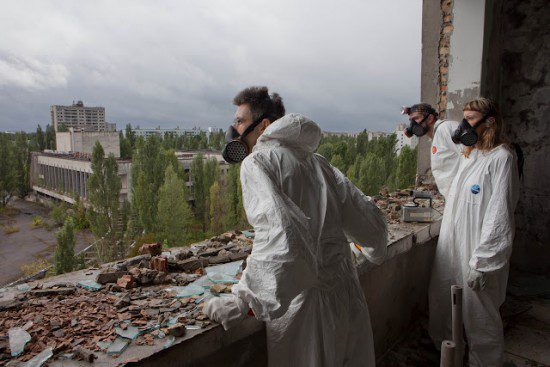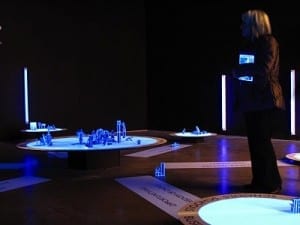Text by Bethany Rex
Eva and Franco Mattes’ current exhibition at Carroll/Fletcher was Anonymous, untitled, dimensions, variable on Wednesday, Building Stories on Thursday and today’s exhibition title remains to be confirmed. If you’re interested in the process of naming you can follow the daily change on their tumblr: www.exhibitiontitlechange.tumblr.com
The Mattes’ call themselves artist-provocateurs who dramatically disrupt the safe environment and conventions of the art gallery. As pioneers of Net Art, the Mattes’ practice inhabits the web and subverts mass media to ultimately expand into and effect the physical space. Their interventions and hoaxes can be traced to the subversive art movements of the Situationist International and Dada, in their diversion of existing cultural productions and the involvement of unaware audiences.
Their first solo show in London is a compelling cacophony of connected facts and fictions where screams echo through the space, the walls are hung with ugly wallpaper and painted blue, green and red; defunt computer monitors and brightly coloured cables snake across the floor, images are suspended from the ceiling; half a museum vitrine emerges from a wall, and in a corner, a replication of Chernobyl’s derelict cinema…there’s a lot going on in this exhibit.
Aesthetica spoke to the Mattes’ to find out a bit more.
BR: Congratulations on opening your first solo show in London! What should we expect?
E&FM: Wallpaper, computers, a dead cat, lots of dead flies and little fragments of famous artworks. Oh, and the title changes every day.
BR: The press material indicates that you will disrupt the “safe environment and conventions of the art gallery.” What are the specific conventions you are referencing here?
E&FM: A lot of our works happen outside of art spaces, on the internet, in videogames or in the street, where the audience behaves very differently than the average art public. For example, if they feel like what you’re doing is stupid, they will say that openly and probably insult you. So we tried to bring some of this “directness” inside the gallery space. I never felt very comfortable in a gallery, and so we’re trying to convey this through the show.
BR: Could you talk us through some of the key works in the show?
E&FM: There are several works that we are showing in the UK for the first time. Our latest thing is called The Others, a slideshow of 10.000 images stolen from private computers. It’s a sort of celebration of digital folklore. The biggest work is a hacked arcade game fitted with a motor that spurs carbon monoxide while played, so if you play for too long you die. While Stolen Pieces is a two years performance in which we’ve been traveling around Europe and the US stealing fragments of artworks from art museums. We’re exhibiting all the fragments and the video documentation of the last theft.
BR: You’ve been described as pioneers of the ‘Net Art Movement’- what distinguishes you from concurrent contemporary art?
E&FM: In the past it was just the fact we used computers and the internet to make art, which other artists generally found weird, if not plain wrong. Things have changed a lot in the last years, and nowadays even the most traditional of painters would probably use a computer for one reason or another. So maybe what differentiates us is that we not only take images and videos from the internet, but that we also try to give something back, publishing our works online before they get to a gallery or museum, and managing that they stay there.
BR: You’re work seems to marry some of the conventions of 20th century art practice to popular web culture and destabilize both forms in these interventions. How do you define your practice? Which takes precedence the Art or the Meme?
E&FM: Maybe artworks are memes in their own right? Visual ideas that spread virally and survive the passing of time through infinite variations…
BR: Some of your work is tied to notions of internet hacking and public disruption. How do you find ways to subvert a subculture which already functions as a provocative or antagonistic force? Do you align your work with the spirit of Anonymous and The Occupy Movement?
E&FM: I wouldn’t say we try to subvert internet culture really. We actually get a lot of inspiration from all kinds of internet subcultures, being it memes, anonymous, videogame freaks or hackers. I’d be more than happy if we managed to even just give the art audience a glimpse into this huge and incredibly creative cornucopia that is the internet, where art is created and exchanged anonymously and freely, for the sake of it. That’s what we tried to do with the work Catt: an anonymous internet meme turned into a sculpture supposedly made – and believed – by the artist Maurizio Cattelan.
BR: Is your work ultimately a kind of Baudrillardian simulacra of reality, both in the virtual and physical realm? How do you hope visitors will experience the exhibition?
E&FM: Our hope is the visitor would leave feeling the “reality of the virtual” is more exciting than “virtual reality”. But we’d be happy if they just don’t find it a complete failure, I guess.
Eva and Franco Mattes, Anonymous, untitled, dimensions variable, 13/04/2012 – 18/05/2012, Carroll / Fletcher, 56 – 57 Eastcastle Street, London, W1W 8EQ. www.carrollfletcher.com
Caption:
Plan C – Chernobyl (2010)
Courtesy the artist





